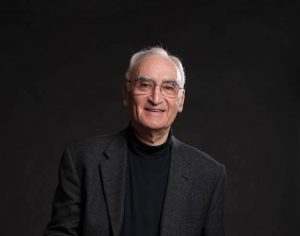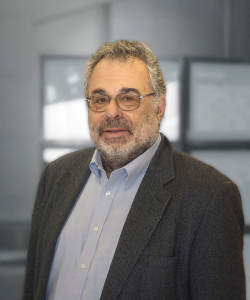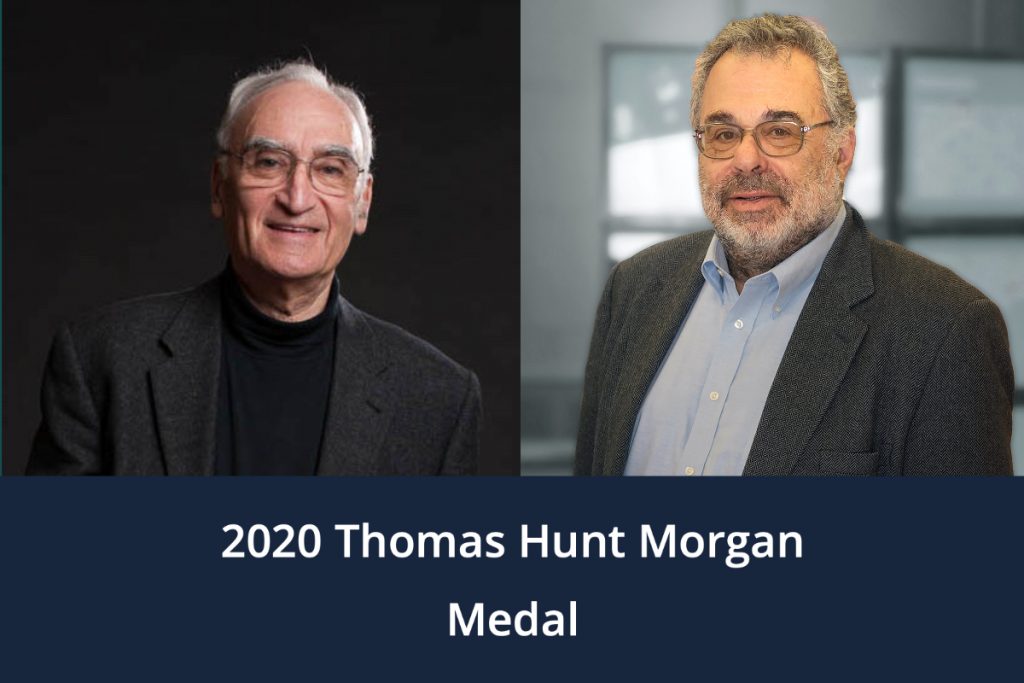For more than 50 years, Gerald Fink of Massachusetts Institute of Technology and David Botstein of Calico Life Sciences have made unique, and sometimes intersecting, contributions to genetics. Together they taught an advanced genetics course at MIT for more than a decade; they’ve co-authored a series of perspective papers and patents. Each has mentored dozens of successful scientists. And this year they are the co-recipients of the 2020 Thomas Hunt Morgan Medal for lifetime achievement in genetics from the Genetics Society of America.
Fink is recognized for the discovery of principles central to genome organization and regulation in eukaryotic cells. Botstein is honored for contributions that include developing methods for defining genetic pathways, mapping genomes, and analyzing gene expression.
“They have each been so important in moving the field forward,” says Erika Matunis, GSA’s Secretary of the Board and Chair of the Awards Committee. “In the end the Board of Directors decided that they both independently merited the medal.”
Gerald Fink: Field Transformer
 Fink’s work in the budding yeast Saccharomyces cerevisiae led to our deep understanding of gene expression control in eukaryotic metabolism. He started working with the organism as a Yale graduate student spurred by the recent discovery in bacteria of operons—clusters of genes with related function controlled by a shared regulatory element transcribed into a single messenger RNA. When he began his own lab at Cornell University, he had set his sights on answering the unresolved question of whether operons also existed in eukaryotes.
Fink’s work in the budding yeast Saccharomyces cerevisiae led to our deep understanding of gene expression control in eukaryotic metabolism. He started working with the organism as a Yale graduate student spurred by the recent discovery in bacteria of operons—clusters of genes with related function controlled by a shared regulatory element transcribed into a single messenger RNA. When he began his own lab at Cornell University, he had set his sights on answering the unresolved question of whether operons also existed in eukaryotes.
When Fink’s career began, the discovery of DNA and the molecular biology revolution had changed little about the study of yeast genetics because there was no method to introduce DNA into a yeast cell, a critical step for tinkering with genes in vivo. Then in 1977 Fink and his group discovered a method to transform yeast with DNA. Yeast transformation allowed the introduction of a DNA molecule from any organism into yeast cells and enabled the manipulation of the expression of those genes. Yeast transformation advanced the field by making it possible to do gene editing and targeting and paved the way for the commercial use of yeast as a factory for manufacturing vaccines and other chemicals.
Once they had the ability to transform yeast, Fink and his group were able to tackle the operon question. They cloned the HIS4 locus, yeast’s best candidate for an operon and showed that it in fact encoded a single multifunctional protein, rather than multiple proteins under common regulation. This finding suggested that eukaryotes were not likely to have bacterial-style operons.
Fink continued to pursue the question of how eukaryotes regulate their genes, as well as many others that piqued his interest. He helped launch the careers of over 100 students and postdoctoral fellows by sharing his research problems. “My students worked on a problem, and then they took it with them,” he says, describing the guiding principle of his lab. “So I was constantly scrambling for new problems.” Fink’s mentoring principle worked well as many of his students have had successful academic careers; seven of them are now members of the National Academy of Sciences.
Many of Fink’s research problems also created whole new directions for the field. Fink and his students showed that many genes related to amino acid biosynthesis were controlled by a single master regulator—the transcription factor Gcn4p. In addition, inspired by Barbara McClintock’s work on jumping genes in maize, Fink and his postdocs discovered that yeast transposable elements, known as Ty elements, move around the chromosomes through retrotransposition via an RNA intermediate. Another student discovered that yeast could divide by a distinct developmental pathway, producing filaments instead of buds. This discovery led Fink’s lab to investigate the genetic wiring that controlled filamentation in both Saccharomyces and in the pathogenic fungus Candida albicans.
“Fink’s research contributions are legion and legendary,” says Jeremy Thorner of the University of California, Berkeley and one of the scientists who nominated Fink for the Morgan Medal. “In addition, he has served the scientific community in important and prominent ways.” In 1970 Fink co-founded the influential yeast genetics course at Cold Spring Harbor Laboratory and taught it for 17 years, sharing his knowledge widely through the yeast community. Many of the students went on to highly successful scientific careers, including three Nobel laureates.
Fink was one of the founders of MIT’s Whitehead Institute and served as its Director for a dozen years. He also served as president of both the Genetics Society of America and the American Association for the Advancement of Science. After the 2001 anthrax attacks, Fink chaired a National Research Council committee on bioterrorism. This committee of scientists, ethicists, and lawyers produced an influential report: “Biotechnology Research in an Age of Terrorism: Confronting the Dual Use Dilemma” also known as the Fink Report due to his imprimatur on this influential document.
David Botstein: Tool Trailblazer
 David Botstein’s genetics research has spanned from phage to humans, tackling key questions related to gene organization and disease and outlining critical mapping work that launched the Human Genome Project. “At every stage of his career, David Botstein has pioneered breathtakingly broad and interesting science. He has developed and popularized generally-applicable tools for genetic analysis and has broken new ground as a teacher and mentor,” says Nancy Kleckner of Harvard University, a former Botstein postdoc, the 2016 Morgan Medal recipient, and one of the scientists who nominated him for the Medal.
David Botstein’s genetics research has spanned from phage to humans, tackling key questions related to gene organization and disease and outlining critical mapping work that launched the Human Genome Project. “At every stage of his career, David Botstein has pioneered breathtakingly broad and interesting science. He has developed and popularized generally-applicable tools for genetic analysis and has broken new ground as a teacher and mentor,” says Nancy Kleckner of Harvard University, a former Botstein postdoc, the 2016 Morgan Medal recipient, and one of the scientists who nominated him for the Medal.
When describing his career, Botstein emphasizes the last part. “I always thought of myself as a teacher,” he says. “To really teach about science, you have to be doing science.” As an MIT instructor, he focused on laboratory teaching and helping students think about how to design, carry out, and analyze experiments. “I was rewarded with the best graduate students wanting to work with me,” he says.
At MIT, Stanford University, and Princeton University, he has mentored more than 100 graduate students and postdocs. More than half are successful academic researchers. Nine are members of the US National Academy of Sciences, and three have already received the Thomas Hunt Morgan medal.
After initially uncovering fundamental features of Salmonella phage P22 genome organization and activity while a graduate student at the University of Michigan, Botstein co-discovered transposable drug resistance elements in bacteria.
In the 1970s, he started working on yeast, with an eye toward applying DNA sequencing to gene analysis. (He took Fink’s CSHL yeast genetics course during its second year.) In 1980, Botstein, Ray White, Mark Skolnick, and Ron Davis outlined how researchers could use restriction fragment length polymorphisms to map the human genome. Though essentially a research prospectus, those ideas paved the way for the Human Genome Project and the entire field of genomics.
That line of research allowed them to link those DNA polymorphisms with disease phenotypes, leading to the mapping and cloning of 1700 disease-related genes, including those linked to Huntington’s Disease and cystic fibrosis. Botstein also worked with fellow geneticist Patrick Brown and others on the development of microarrays to measure gene expression, a technique that was key in opening up the modern era of genome-wide analysis. In 2000, Botstein, Brown and their team built on this approach to classify human breast tumors into subtypes based on their microarray gene expression profiles. “That has had a big direct clinical effect because there are tests out there now that can tell women how much they should worry about their tumors and how aggressive treatment they need,” he says.
Over the decades of his career, Botstein became concerned by the structure of scientific training. Increasingly, he observed two trends: undergraduate students didn’t receive a sufficiently rigorous education across scientific disciplines, and PhD scientists didn’t achieve research independence until sometime in their 40s. In 2003, he moved to Princeton to take on these issues as leader of the Lewis-Sigler Institute of Integrative Genomics. Undergraduates took a two-year rigorous curriculum across math, physics, chemistry, and biology and could then major in any scientific discipline. At the same time, the Institute supported early career research fellows, nominated directly out of graduate school, who received five years of funding to pursue their own projects and participate in undergraduate teaching. “They did so much better than any subset of postdocs,” Botstein says. “I felt that was a great success.”
Throughout his career, Botstein has viewed the researchers in his group, from undergraduates to postdocs, as collaborators, “who knew a little less than I did.”
“Both Botstein and I pride ourselves in the cultivation of our students,” Fink adds. “That’s your legacy.”
Gerald Fink and David Botstein will accept their medals at The Allied Genetics Conference (TAGC) 2020, held April 22–26, 2020.
The Thomas Hunt Morgan Medal is awarded to individual GSA members for lifetime achievement in the field of genetics, recognizing the full body of work of exceptional geneticists. Recipients will have made substantial contributions to genetics throughout their careers and will have a strong history as a mentor to fellow geneticists.
GSA established the Medal in 1981 and named it in honor of Thomas Hunt Morgan (1866-1945). Morgan received the Nobel Prize in 1933 for his work with Drosophila and his “discoveries concerning the role played by the chromosome in heredity.” Morgan’s studies of the white mutation and discovery of sex-linked inheritance provided the first experimental evidence that chromosomes are the carriers of genetic information. Subsequent studies in his laboratory led to the discovery of recombination and the first genetic maps.
Nominations for the 2021 GSA Awards will open in September 2020.













